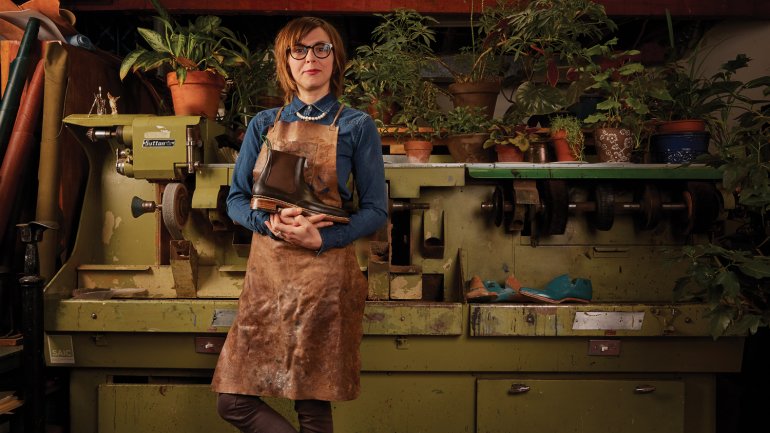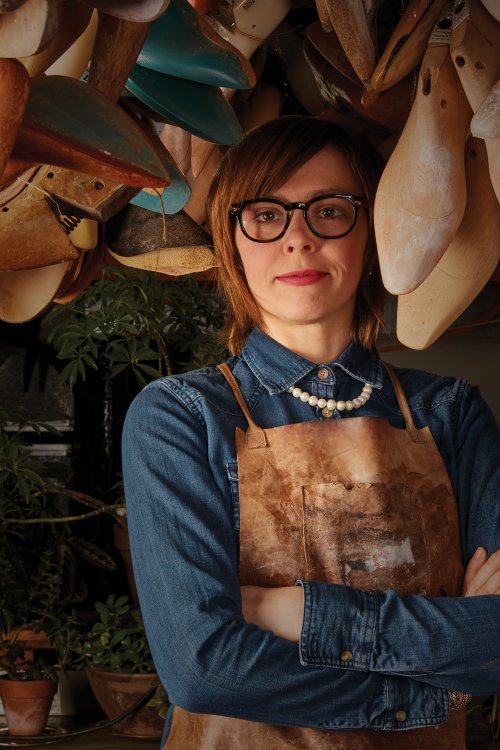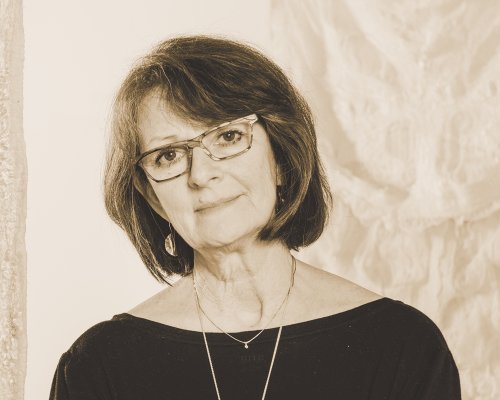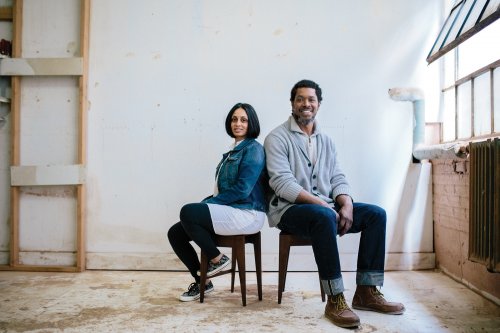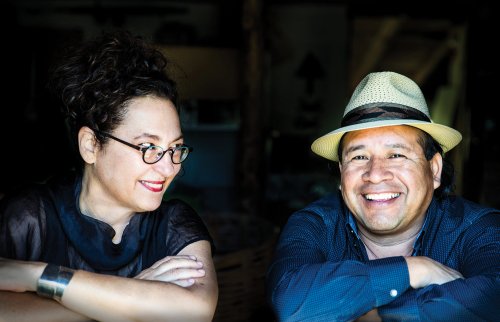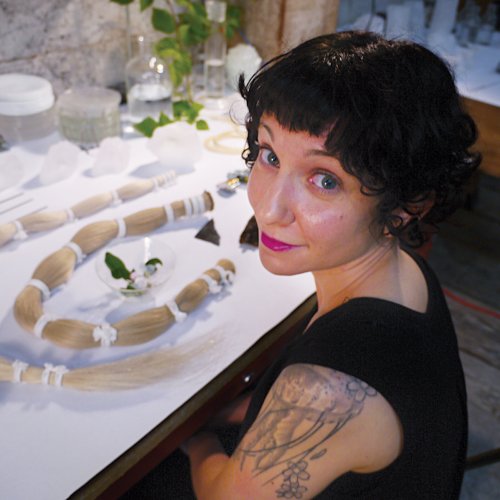Rare Form
Rare Form
The Rare Craft Fellowship Award, presented by the ACC in association with whiskymaker The Balvenie, recognizes artists in time-honored disciplines. Meet this year's honorees.
Amara Hark-Weber
Winner
“People think shoemaking is going to be easy and fun, and it’s neither easy nor fun,” explains Amara Hark-Weber, who makes shoes in a small basement studio in St. Paul, Minnesota. “It’s a lot harder than people think that it is, and it’s a lot slower.”
The 35-year-old knows something about shifting expectations. A car accident and traumatic brain injury in the final year of her MFA studies meant Hark-Weber couldn’t continue in the visual communications and design program at the School of the Art Institute of Chicago. Instead, she took a shoemaking class there, fell in love with the process, and managed to graduate on time despite rehabilitation appointments three days a week.
“My brain got a reboot and had to learn a new operating system,” she says. “Only head-injury people would think they could do such crazy things.”
Since that turn of events, Hark-Weber has continued to adapt, primarily through a rigorous self-guided education. In just under five years, she has gone from the glued-together concept shoes that comprised her MFA thesis to bespoke footwear made by hand with machine-like precision. Hark-Weber tempers her high expectations with the understanding that mastering shoemaking takes a lifetime.
“I like the long learning curve,” she says. “I’m in it for the long haul.”
In that spirit, Hark-Weber seeks to learn from others devoted to the craft. First, a month in 2013 with master bootmaker D.W. Frommer gave her the basics of cowboy-boot construction and other shoemaking essentials. His traditional boots drew Hark-Weber’s interest, and his lifetime of experience was invaluable to her early development.
“One of the things that D.W. taught me is that the most important skill that you need as a shoemaker is how to sharpen your knife,” she remembers. “You’ll save your body, you’ll save time, and you’ll have better work.”
In 2014, she traveled to Sweden to learn more about handmade men’s shoes from another master, Janne Melkersson. Three weeks of 10-hour days yielded two pairs of shoes, a pair of riding boots, and a deeper understanding of the skills she would need to develop further.
Last November, Hark-Weber spent a few weeks working with Hungarian-born master Marcell Mrsan in his workshop in Savannah, Georgia.
“I was there for a month, sleeping on the floor, with no hot water or shower. It was so intense,” she says. “He does not suffer fools, and he is very, very good.”
At every stage of the process – from building a last (the three-dimensional form on which a shoe is shaped), to patterning, sewing, and precision knife-work – shoemaking is complex, with ample opportunity to make mistakes that could ruin the final product.
Only a shoemaker “really understands how long it takes – how much sweat, how much skill, how much vision it takes to make these objects,” says Hark-Weber. “If I didn’t love to do this, I would not do it.”
For an independent business-person, the stakes are even higher, as mistakes cost valuable time and materials.
“Once you’re getting toward the end of that shoe, you’ve got 40 hours of work invested. You probably have a couple blisters, maybe a cut or two. Leather is expensive,” she says. “So if you slip, it’s a really sad moment.”
Fortunately for Hark-Weber, she’s had a good model for managing the risk that comes with running a creative business. Her mother, Mary Hark, is an artist and papermaker.
“It is amazing and unusual to have someone in my corner with such a personal understanding of this path,” says Hark-Weber. “She modeled a type of interaction with the world that is unafraid.”
Today, Hark-Weber’s focus is on building a business that can sustain her appetite for learning and on making clients happy. Successful custom fittings, she says, can be heard: If the fit is perfect, you’ll hear a rush of air escape as the foot enters.
“Then they stand up, and they walk, and they twirl, or do a dance move, and smile,” she says. “No matter what I think about the shoes, if the client is happy, I am super-happy. I’m ecstatic.”
While she’s lost count of how many shoes she’s created, Hark-Weber loves to celebrate the discoveries that come when you put your head down and work.
“Because I am so focused on every step individually, when I finish a shoe, sometimes I feel like I’m looking at a stranger. I’m like, ‘How did you appear here? My God – did I make you? ’ ” she says. “All of a sudden there’s this beautiful, shiny thing. It’s incredible.”
Watch a video interview with Hark-Weber in her studio.
Janice Arnold
Finalist
Feltmaker Janice Arnold remembers tearing apart clothes she inherited from three older siblings to make something new.
“By deconstructing, I learned about construction techniques, which led to an appreciation for clothing design,” says the artist, who lives near Olympia, Washington. “This experience nurtured an already strong creative spirit, which evolved into a passion.”
Arnold’s passion for textiles is easy to see in her large-scale, immersive installations, such as 2009’s Palace Yurt for the Cooper-Hewitt, Smithsonian Design Museum, or her work in “Felt Decoded,” her 2017 solo exhibition at San Francisco’s Museum of Craft and Design. Her work is rich in textures that beg to be touched. But Arnold says creating her work goes beyond a physical act.
“It is a path, a journey, and a life of refinement and craftsmanship that is continually evolving,” she says, “providing one is open to listening to the voice of the materials and letting them be the guide.”
Ali Sandifer
Finalist
Each piece in Ali Sandifer’s collection of elegant modern furniture starts with a conversation between Abir Ali and her husband and partner-in-design, Andre Sandifer. From there, prototyping begins; many ideas see up to three full-sized iterations before reaching the public, all sketched and built by hand.
Building by hand, says Ali, is critical to their process. “I honestly feel like that’s the soul,” she says. “We both came from architecture backgrounds, and we’re both designers, and we challenged ourselves to go into craft.”
The craft process, unlike the computer-aided design the Detroit couple learned in school, allows an intimacy with materials, dimensions, and scale.
“You can’t get that in a drawing,” says Sandifer. “I think people have an appreciation when someone handmakes something; it’s almost an extension of that person.”
Each piece they make – from the Edith credenza to the Mag coffee table to the Tele side table – results from months of collaboration, Sandifer in the workshop and Ali handling the creative direction and day-to-day business.
It all comes together artfully in work and life. “We say our greatest prototype has been our son, Rami,” jokes Ali. “He truly has made us a mom-and-pop operation.”
Martinez Studio
Finalist
The collaborative painting and weaving work of Sandra and Wence Martinez is impossible to separate from the pair’s love story – starting with an unlikely encounter that happened when Sandra went to a weaving village near Oaxaca, Mexico, where Wence was working; a friend had suggested that Sandra’s imagery would translate well to a woven form. After their meeting came the first of countless collaborations uniting Sandra’s symbolist painting with Wence’s traditional weaving. The duo fell in love and moved to Door County, Wisconsin, where they opened Martinez Studio in 1994.
“We focused on crafting a life that would feed our need to be engaged daily in making,” says Sandra. “We picked a lane and bloomed where we were planted.”
Bloom they did. The couple first drew national attention after participating in the 2012 Architectural Digest Design Show in Manhattan. They have since been a part of five consecutive Smithsonian Craft Shows, and one of Wence’s weavings, Codice Nuttall, was acquired for the permanent collection at the National Museum of Mexican Art in Chicago in 2015.
Still, the pair remains humble in their daily practice, saying they measure success by being able to support themselves and their family.
“We often say, ‘We make things, and nice people take them home,’ ” says Wence.
Emily Nachison
Finalist
Emily Nachison’s ethereal sculptures, clear and crystalline, belie the artist’s recent entrée into kiln-formed glass. Nachison was introduced to the medium in 2013 at a workshop with Bullseye Projects, an affiliate of Bullseye Glass Co. in Portland, Oregon, where Nachison lives.
“I began working with glass thinking it would be an interesting new element to include in my work,” says Nachison, who has an extensive background in fiber. Instead, glass took over her practice.
“Glass, with its aesthetic, scientific, and practical history, represents preservation while simultaneously signifying fragility and impermanence,” she says.
Installations such as Constellation Field (2016), with more than 200 glass pieces suspended from high ceilings on thin chains, confront ideas of fragility yet retain a mystical aura. Other sculptural works – Diver, for example, which resembles clamshells, or Apparition, with its ghostly, white-maned horses – combine familiar forms with Nachison’s penchant for the otherworldly.
“I am interested in how materials and objects can speak to us –and often express emotions, experiences, and memories that words cannot,” she says.
Watch a video with all of the 2017 Rare Craft Fellowship Award finalists.


